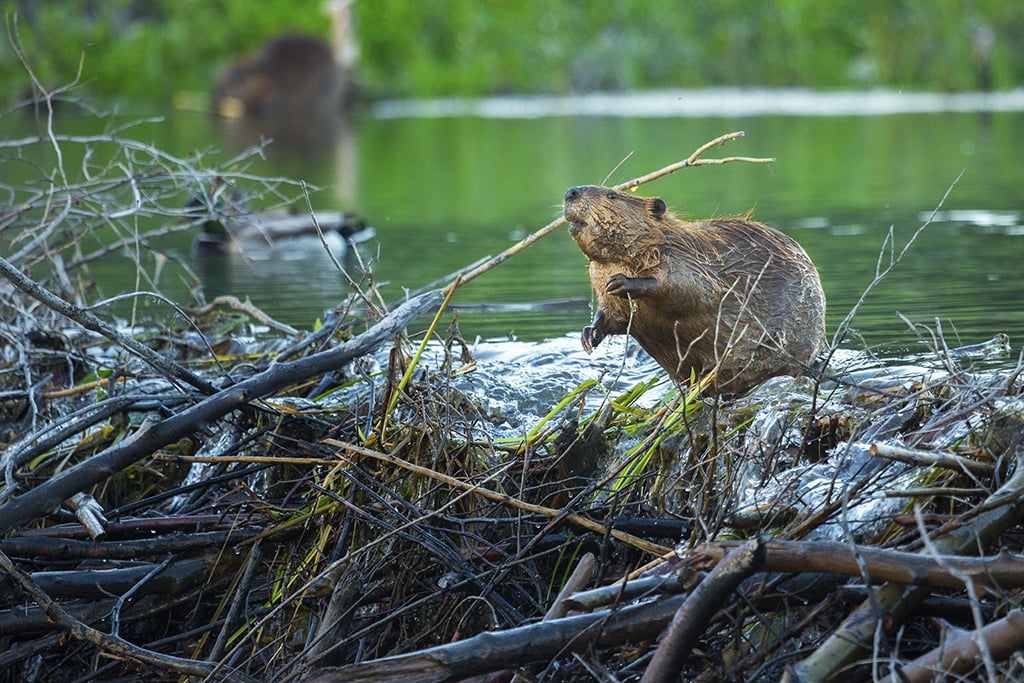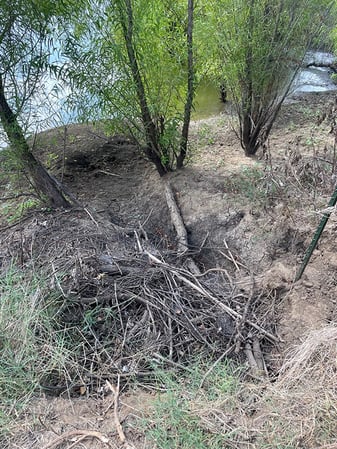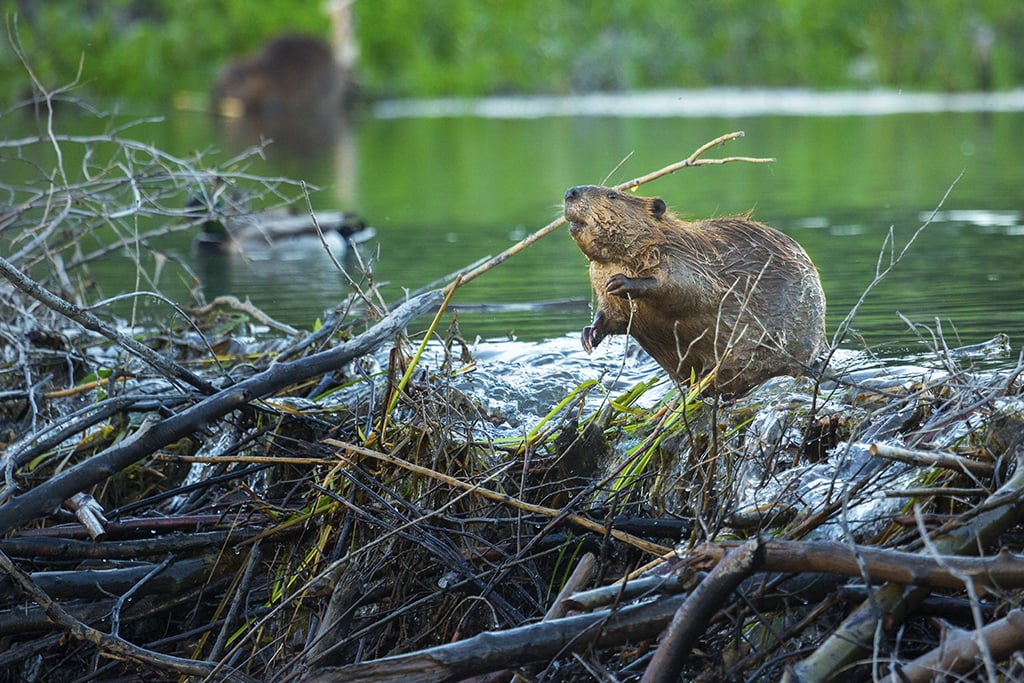If you have owned a pond for very long there is a good chance that you have run across some nuisance wildlife at one time or another. As a private pond owner, you should be aware of the damages from riparian mammals such as Otters, Beavers, and Muskrats and how they affect your pond as well as a few management strategies.

Common Nuisance Aquatic Mammals
American Beaver (Castor canadensis)
At 23-39 inches long, the American Beaver is the largest rodent in North America and is widely known for its natural engineering abilities. Beavers often find their way into private lakes and ponds and can cause structural damage to the waterbody. Most everyone knows beavers have a natural instinct to build dams and inhibit the flow of water. While this can be beneficial in the wild, as it can provide watering holes and improved habitat for many species, it can lead to the destruction of man-made ponds.
Why Beavers are Harmful to Your Pond
Beavers can affect your pond in two major ways, disruption of spillways and reduction of shoreline habitat. They can also cause damage to wiring on aeration systems, fountains or boats.

Disruption of Spillways
Most man-made ponds and lakes have a spillway that flows out around the dam in the event of high water. The purpose of these spillways is to maintain a maximum water level to prevent flow over the dam and dam failure as a result.
As we mentioned earlier it is a natural instinct for beavers to inhibit the flow of water. If beavers were allowed to dam up a spillway, water would be forced to find a new path out of the lake. This could be over the dam or around in a different place.
Either way, increased water velocity through a new path of least resistance leads to increased head cutting and increased structural damage to the dam or surrounding land.
Reduction in Shoreline Habitat
Reduction in shoreline habitat is the result of beavers cutting down trees for use in dam building and for bark and cambium consumption. This reduces available habitat for larval and juvenile fish to evade predation as well as habitat for macroinvertebrates.
How to Prevent or Remove Beavers
Reducing the availability of woody vegetation along the shoreline can be done as a preventative measure to create less suitable habitat for beavers. If beavers are already within the waterbody, trapping to remove them may be the best option. Conibear traps are often chosen for beaver trapping. Remember to always check state regulations on furbearer trapping to ensure compliance within the established laws and regulations.
Muskrat (Ondatra zibethicus)
The muskrat is another very common rodent that might be found in your pond. They are large rodents that are very similar to a rat, gerbil or hamster. They are quite round with short legs and invisible ears and can grow to be 16-25 inches long. Like beavers, muskrats can be detrimental to your pond structure and habitat.
How Muskrats Damage Your Pond
The muskrat is another very common rodent that might be found in your pond. They are large rodents that are very similar to a rat, gerbil or hamster. They are quite round with short legs and invisible ears and can grow to be 16-25 inches long. Like beavers, muskrats can be detrimental to your pond structure and habitat.
What Do Muskrats Eat?
The diet of Muskrats mainly consists of aquatic plants. This predation on aquatic plants reduces available habitat for juvenile/larval fish, macroinvertebrates, and reduces shoreline stability.
How to Prevent or Remove Muskrats
Just as with beavers, preventative measures against muskrats consist of reducing suitable habitat. However, since a habitat that is suitable for muskrats is actually recommended for fish and shoreline stability, a challenge is presented. The best solution and compromise is to reduce the suitable habitat in areas of your pond or lake that are most at risk of damage due to muskrat burrows. These locations include pond dams and banks already at risk of accelerated erosion.
Improve Your Pond’s Vegetation to Help Prevent Muskrat Burrows
Maintaining a reduced density of aquatic vegetation (cattails, rush spp., and pondweed spp.) in these areas help to prevent the likelihood of a present muskrat creating a burrow in that area.
Is Trapping a Viable Solution for Muskrat Removal?
Trapping is a successful removal technique if muskrats are already present. Conibear traps are a popular choice for this application. Check area furbearer regulations to ensure compliance within the established laws and regulations.
Northern River Otter (Lontra canadensis)
Northern river otters are found throughout most of the United States and can find their way into your pond from time to time. Unlike the other nuisance animals that have an indirect effect on your fish populations, river otters have a direct impact on the fish populations within your lake or pond.

Why River Otters are Bad for Your Pond
While they may seem cute and playful as they’re swimming and diving through the water, otters are predators. Their diets consist of fish, amphibians, and other aquatic organisms.
Otters are able to capture and consume larger fish than most other nuisance wildlife which accelerates their effect on the fishery. As a result, the reproductive potential of the fishery is immediately reduced. Prolonged inhabitance of otters can have a significant impact on the aquatic ecosystem. Immediate removal is strongly recommended as supplemental fish stockings may be necessary following exposure to otters.
How to Remove River Otters from your Pond
Removal of otters is best done by trapping. Commonly used traps include snare, leg hold, conibear, or in cases where the otter is to be relocated a live trap baited with fish or scent from another otter can be used. As mentioned earlier, follow all state regulations for trapping and removal of otters.
Contact Pond King for Help with Private Pond Management
Wildlife issues can be fairly common if your property is located near a larger body of water or stream. Knowing how to recognize signs that these species are present allows for quicker response and reduced damage to the fishery/habitat. If you have any further questions regarding nuisance species in your pond feel free to contact me at ethan@pondking.com or by calling our office at (940) 668-2573



